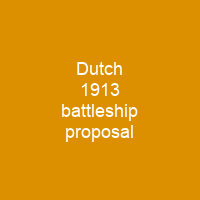Why Did the Dutch Consider Building New Battleships in 1912?
The Dutch Government faced a critical decision in 1912: should they invest heavily in new battleships to protect their colonial empire, or focus on other priorities? This question was at the heart of a proposal that would have dramatically reshaped the Dutch Navy. The backdrop for this decision was the growing naval ambitions of Japan and the withdrawal of British warships from the China Station. These factors led to a sense of urgency among Dutch policymakers who feared their colonial possessions in the East Indies might be vulnerable.
The Threat of Japanese Expansion
Japan’s rapid modernization and expansionary policies were seen as a direct threat to Dutch interests in the region. The Russo-Japanese War (1904-1905), which Japan won, highlighted the vulnerability of colonial empires to rising powers. This war was a wake-up call for the Dutch, who realized that their naval forces were woefully inadequate to face such challenges.
Commissioning New Battleships
A Royal Commission was formed in 1912 to assess the necessary steps to improve defenses in the East Indies. The commission considered various options, including coastal defense ships and submarines, but ultimately recommended acquiring nine dreadnought-type battleships. These battleships would be built by Germaniawerft, a renowned shipbuilding firm known for its innovative designs.
Design Specifications
The proposed battleships were to have eight 343 mm guns and two fewer medium guns compared to other designs. They would be faster and have longer range than current designs but at the expense of lighter armor protection. The Dutch Government was considering a bill seeking funding for four such battleships, which was withdrawn in August 1914 due to the outbreak of World War I.
International Relations and Neutrality
The Royal Commission’s recommendations were based on the deteriorating international relations in the Pacific. The Dutch Government saw the need for a powerful fleet not only to enforce neutrality but also to offer a credible defense against potential threats. However, some members of the commission argued that such a move would be unwise given the rapid naval expansion by major powers and could hinder Dutch neutrality.
Proposed Fleet Composition
The plan included nine dreadnoughts with specific specifications: speed of 21 knots, 340 mm guns, 150 mm and 75 mm secondary armament. The fleet would also include six torpedo cruisers, eight destroyers, eight large submarines, two minelayers, and four battleships based in the Netherlands and NEI. This ambitious plan was estimated to cost €595,000,000 over 35 years, tripling the Navy’s budget and requiring a manpower expansion of 2,800 sailors.
Debate and Controversy
The debate over the proposal was extensive. Critics argued that joining the naval arms race would be unwise and that competition between major powers meant none could allow another nation to occupy either the Netherlands or the NEI. The Governor-General of the NEI advocated for seven battleships in the Indies, which could be financed by reducing the planned battleship force in European waters.
Proposed Ship Design
The Germaniawerft submitted two revised designs for the battleships before the Royal Commission’s recommendations were considered. The first design, Project No. 753, included main armament in superfiring turrets and other changes. A second design was later proposed, which increased displacement to 20,700 tons and substituted eight 343 mm guns.
Public Debate and Funding
The public debate centered on who would benefit from the ships and how to divide the costs fairly. Onze Vloot published pamphlets arguing that Dutch rule was beneficial and that residents would pay for ships to ensure its continuation. The government postponed parliamentary discussions, gaining momentum for a fleet. To fund the fleet, the minister proposed increasing taxes on export duties and freight.
Outcomes and Future Plans
A bill setting out funding arrangements was finalized in July 1914 but withdrawn due to World War I. Instead, three Java-class cruisers were ordered, with only two completed. A new Royal Commission recommended completing existing ships and adding a few more vessels, but the plan was deemed unaffordable. In the late 1930s, renewed concerns led to a proposal for three battlecruisers, but construction had not begun when the Netherlands was invaded in 1940.

The story of the Dutch battleship proposal in 1912 is a testament to the complex interplay between national security, economic constraints, and international politics. It serves as a reminder that even in times of peace, nations must constantly reassess their strategic needs and priorities. The fate of these proposed ships highlights the challenges faced by any country when deciding on such significant military investments.
You want to know more about Dutch 1913 battleship proposal?
This page is based on the article Dutch 1913 battleship proposal published in Wikipedia (retrieved on November 29, 2024) and was automatically summarized using artificial intelligence.







